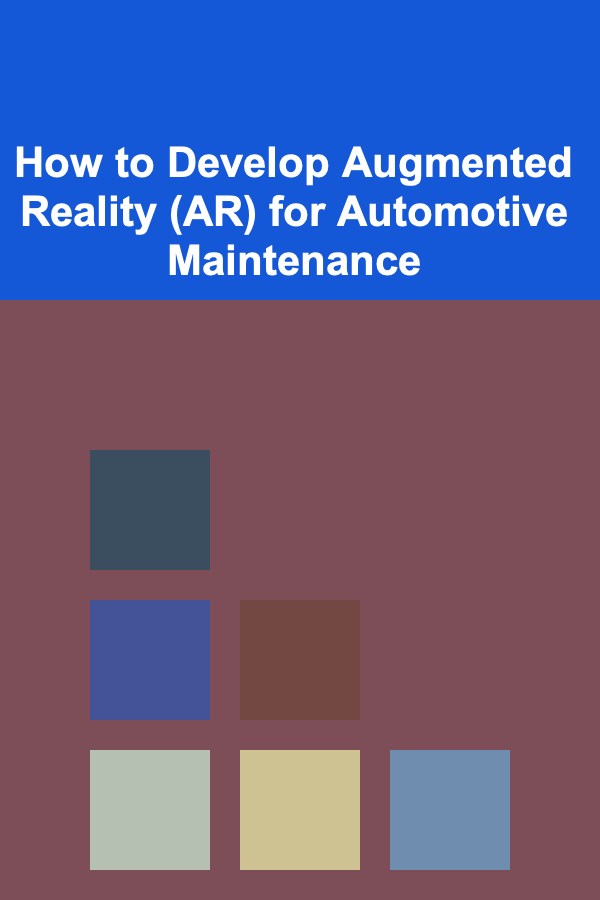
How to Develop Augmented Reality (AR) for Automotive Maintenance
ebook include PDF & Audio bundle (Micro Guide)
$12.99$9.99
Limited Time Offer! Order within the next:

The rapid advancements in technology have significantly reshaped industries, and the automotive sector is no exception. One such transformative technology is Augmented Reality (AR), which has shown considerable potential in automotive maintenance. AR blends the physical world with digital content, offering a richer experience and providing real-time, context-aware information. In automotive maintenance, AR can enhance technicians' capabilities by providing guidance, diagnostics, and real-time overlays of vehicle information, significantly improving efficiency and accuracy.
This article delves into the process of developing AR applications for automotive maintenance, covering the key stages involved, from concept design to deployment. It will explore the tools and technologies used, the challenges faced, and the benefits of integrating AR into the automotive industry.
Understanding the Role of AR in Automotive Maintenance
AR in automotive maintenance provides a digital overlay of information on the physical world, helping technicians perform tasks with greater accuracy. For example, it can display step-by-step instructions for replacing a brake pad, highlight defective components, or provide real-time diagnostics of the vehicle's systems. By using AR, technicians are not only more efficient but can also minimize errors, reduce downtime, and enhance the overall quality of service.
Benefits of AR in Automotive Maintenance
- Efficiency and Speed: With AR, technicians no longer need to flip through manuals or search for information online. They can access necessary details instantly.
- Improved Accuracy: AR can guide technicians with precise instructions, ensuring that repairs are done correctly the first time.
- Training and Skill Development: New technicians can use AR to learn tasks with guidance from the system, which enhances hands-on training without the risk of making costly mistakes.
- Remote Assistance: AR can enable remote experts to view the maintenance process in real-time and offer guidance, improving first-time fix rates.
Key Technologies Behind AR in Automotive Maintenance
The development of AR applications relies on a combination of hardware and software technologies. Some of the key components include:
2.1 AR Hardware
- Smart Glasses: Devices like Microsoft HoloLens or Google Glass provide a hands-free interface for AR. Technicians can wear these glasses, and the device will project information directly into their field of view.
- Mobile Devices: Smartphones or tablets equipped with cameras can also be used to view and interact with AR content. These devices offer a more affordable and portable solution.
- Cameras and Sensors: Cameras and depth sensors are essential for capturing real-world images and processing them to place virtual elements accurately in the environment.
2.2 AR Software
- SLAM (Simultaneous Localization and Mapping): This technology is essential for recognizing and mapping the physical space to place digital content in the correct position.
- Image Recognition: AR applications use image recognition algorithms to identify vehicle parts and overlay relevant maintenance instructions on the screen.
- 3D Modeling and Visualization: AR applications require 3D models of vehicle components and systems. These models need to be accurate to ensure the AR overlays are correct.
- Cloud Integration: Cloud services allow the AR system to store and retrieve vast amounts of data, such as vehicle manuals, repair histories, and diagnostic reports.
Design Considerations for AR in Automotive Maintenance
Developing an AR application for automotive maintenance involves careful consideration of several factors to ensure the tool is useful and user-friendly. Here are the key aspects of designing such applications:
3.1 User Experience (UX) Design
- Intuitive Interface: The application should be easy to use, even for technicians with little or no prior experience with AR. The interface must be intuitive, with minimal distractions and clear, concise instructions.
- Hands-Free Operation: In an automotive workshop, technicians often work with tools and parts, making hands-free control essential. Voice commands or gesture controls can be used to interact with the system.
- Real-Time Data Display: AR should display relevant, real-time data like sensor readings, component health, and step-by-step instructions.
- Error Detection and Feedback: The AR system should highlight errors, offer corrective actions, and provide immediate feedback to prevent mistakes.
3.2 Contextual Relevance
- Vehicle-Specific Information: AR applications must be able to differentiate between various models and offer maintenance information specific to the car. For instance, an electric vehicle (EV) may require different maintenance protocols than a traditional internal combustion engine vehicle.
- Real-Time Diagnostic Data: The system should integrate with onboard diagnostics (OBD) systems to provide real-time error codes, engine data, and performance statistics, allowing technicians to make data-driven decisions.
- Interactive Guidance: For tasks like replacing a fuel filter or inspecting brake pads, the system should offer an interactive, step-by-step guide, visualizing the process in 3D and highlighting key areas.
3.3 Data Integration
- Vehicle Databases: The AR system must integrate with vehicle databases to provide technicians with accurate, up-to-date maintenance schedules, service history, and component specifications.
- Real-Time Updates: As AR systems are often connected to the internet or cloud services, they can receive updates, ensuring that the technician always has access to the latest information and procedures.
Development Process for AR in Automotive Maintenance
4.1 Research and Conceptualization
The development of AR for automotive maintenance begins with identifying the specific needs of the target users---automotive technicians, service managers, and customers. During this phase, you must:
- Identify User Needs: Conduct surveys, interviews, or workshops with automotive technicians to understand their pain points and requirements.
- Define Key Features: Decide which features the AR app should include, such as real-time diagnostics, step-by-step maintenance guides, remote assistance, or vehicle-specific information.
- Research Tools and Platforms: Choose the appropriate AR development platform (such as Unity, ARKit, ARCore) and hardware (smart glasses, mobile devices) based on your requirements.
4.2 Prototyping and Testing
Once you have a clear understanding of the requirements, the next step is to create a prototype. This prototype should:
- Visualize Key Functions: Create AR models, instructions, and diagnostic overlays to test how the system interacts with real-world objects.
- Incorporate Feedback: Test the prototype with a small group of technicians to gather feedback on usability, accuracy, and effectiveness.
- Iterate: Based on feedback, iterate on the design and functionality. For example, you might improve the interface or enhance the accuracy of image recognition.
4.3 System Integration
AR applications in automotive maintenance need to integrate with several systems:
- OBD-II Integration: Onboard diagnostics systems can provide real-time data on the vehicle's health, which can be overlaid in the AR interface.
- Cloud Databases: Maintenance manuals, service records, and diagnostic tools need to be accessed from the cloud, ensuring the most accurate and up-to-date information is available.
4.4 Deployment and Maintenance
Once the AR application is fully developed, it can be deployed in automotive repair shops or for training purposes. Deployment might include:
- Installation on Devices: Whether through mobile devices or smart glasses, the system must be installed on the devices that technicians use.
- Training: Technicians may need training on how to use the AR system effectively.
- Post-Deployment Support: Ensure that the system is maintained and updated regularly to include new vehicles, diagnostic tools, and maintenance procedures.
Challenges in Developing AR for Automotive Maintenance
While the potential of AR in automotive maintenance is immense, there are several challenges to overcome in the development process:
5.1 Hardware Limitations
The performance of AR applications can be affected by the hardware available. Smart glasses, for example, may have limitations in terms of processing power, display quality, and battery life. Mobile devices, while more versatile, may not provide the same immersive experience.
5.2 Image Recognition Accuracy
For AR to function correctly, the system must recognize vehicle components accurately. Ensuring that the application can correctly identify and map vehicle parts in real-time is a significant challenge, especially given the variety of components and vehicles.
5.3 Integration with Existing Systems
Automotive workshops often use legacy systems for diagnostics and maintenance tracking. Integrating AR with these older systems while ensuring data consistency can be a complex task.
5.4 Cost and Accessibility
Developing AR for automotive maintenance can be costly, especially if high-end hardware like smart glasses is required. Moreover, not all repair shops may have the resources to adopt this technology, limiting its reach.
Future Directions
As AR technology evolves, its applications in automotive maintenance will continue to grow. Future advancements may include:
- AI Integration: Artificial intelligence could play a significant role in enhancing the predictive maintenance capabilities of AR systems, allowing them to anticipate issues before they arise.
- Remote AR Assistance: Experts could remotely guide technicians through complex repairs, enhancing collaboration and knowledge-sharing across global service networks.
- Enhanced 3D Visualization: With the continued development of 3D rendering technologies, AR could offer more immersive, realistic visualizations of vehicle components.
Conclusion
The development of AR for automotive maintenance offers vast potential to improve efficiency, accuracy, and safety within the automotive repair industry. By leveraging technologies like image recognition, SLAM, and cloud integration, AR can provide real-time, contextual information to technicians, ultimately enhancing their decision-making process. While there are challenges in terms of hardware, integration, and cost, the future of AR in automotive maintenance looks promising, with continued advancements expected to make this technology more accessible and effective. As the industry embraces innovation, AR will undoubtedly play a pivotal role in shaping the future of automotive maintenance and repair.

How to Enhance Your Home's Mood with Color-Changing Lighting
Read More
How to Light Your Home for Energy Efficiency
Read More
How to Reduce Your Home's Carbon Footprint and Save Money
Read More
How to Use Digital Scrapbooking for Creative Organization
Read More
How to Predict the Future of Blockchain Technology
Read More
How to Let ChatGPT Help You Explore New Hobbies
Read MoreOther Products

How to Enhance Your Home's Mood with Color-Changing Lighting
Read More
How to Light Your Home for Energy Efficiency
Read More
How to Reduce Your Home's Carbon Footprint and Save Money
Read More
How to Use Digital Scrapbooking for Creative Organization
Read More
How to Predict the Future of Blockchain Technology
Read More